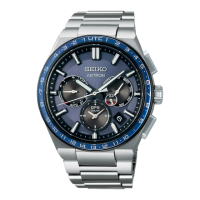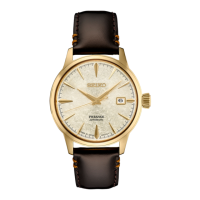Why has my Seiko SSC141P1 stopped working?
- BBrandon DeckerAug 6, 2025
If your Seiko Watch stops operating, it is likely that the energy has been depleted. Recharge the watch sufficiently by exposing it to light.
Why has my Seiko SSC141P1 stopped working?
If your Seiko Watch stops operating, it is likely that the energy has been depleted. Recharge the watch sufficiently by exposing it to light.
Why does the date on my Seiko SSC141P1 Watch change during the day?
If the date on your Seiko Watch changes during the day, the time is likely set 12 hours ahead of or behind the correct time. Reset the time correctly, referring to “SETTING THE TIME AND ADJUSTING STOPWATCH HAND POSITION.”
What to do if Seiko SSC141P1 Watch doesn't resume normal after charging?
If your Seiko Watch has been charged for longer than required, but the second hand does not resume one-second interval movement, consider these possible causes: 1. The light the watch has been exposed to was too weak. Recharge the watch referring to "GUIDELINE OF CHARGING TIME/ACCURACY." 2. The built-in IC has fallen into an unstable condition. Reset the watch by following the instructions in “IMPROPER FUNCTION." 3. The watch has been left or worn in extremely high or low temperatures. Return the watch to a normal temperature so that it works accurately as usual, and then reset the time. 4. The watch has been left close to an object with a strong magnetic field. Correct this condition by moving and keeping the watch away from the magnetic source.
Why is the second hand on my Seiko SSC141P1 Watch moving at two-second intervals?
If the small second hand on your Seiko Watch moves at two-second intervals, it indicates that the energy is running short. To resolve this, recharge the watch sufficiently by exposing it to light.
How to fix Seiko SSC141P1 when stopwatch hands don't return to zero?
If the STOPWATCH hands on your Seiko Watch do not return to the "0" position when the stopwatch is reset, it may be affected by external sources, or because the internal IC had been reset, the stopwatch hand positions have moved out of correct alignments. To fix this, adjust the STOPWATCH hands to the "0" position by following the instructions in “SETTING THE TIME AND ADJUSTING STOPWATCH HAND POSITION.”
Displays current time and date information.
Measures elapsed time up to 60 minutes in 1/5-second increments with split time.
Allows setting a single alarm within a 12-hour period for a specific time.
The watch is powered by light energy, eliminating the need for battery replacements.
Indicates the watch does not require regular battery replacements due to its solar power.
Specifies the operational duration of approximately 6 months after a full charge.
Alerts the user with a 2-second interval movement when the watch's power is low.
Protects the watch's battery from damage by automatically stopping charging when full.
Identifies the watch's display elements, sub-dials, and physical buttons.
Details the operation and security mechanism of the screw-lock type crown.
Procedure for setting the main time and date on the watch.
Instructions for adjusting the alarm hands to match the main time display.
Guide to setting the stopwatch hands to their zero positions.
Steps for correctly setting the watch's date, including special month considerations.
Overview of the stopwatch's measurement capabilities, including 1/5-second increments and split time.
How to perform a standard measurement using the stopwatch function.
Using the stopwatch to measure and track accumulated elapsed time.
Procedure for measuring and displaying split times during stopwatch operation.
How to measure and record the finish times of two competitors.
Instructions for resetting the stopwatch hands to their zero positions after use.
Guide for setting the desired alarm time in one-minute increments.
How to manually stop the alarm when it rings or automatically disengages.
Procedure to preview the alarm sound using the demonstration function.
Steps to cancel an already set alarm time by returning hands to current time.
Instructions for charging the watch using light and initiating its operation.
Important safety warnings regarding watch charging to prevent overheating.
Explanation of the function that protects the battery from overcharging.
Provides guidelines for charging times based on different light sources and environments.
Details the function that indicates low power levels through 2-second hand movement.
Information about the rechargeable battery, its efficiency, and potential degradation.
Warning regarding the need for professional knowledge for rechargeable battery replacement.
Procedure to reset the watch's internal IC to resolve abnormal display or function issues.
How to use the tachymeter scale with the stopwatch to calculate average vehicle speed.
Using the tachymeter to determine the hourly rate of operations or jobs completed.
Instructions for using the telemeter scale to estimate distance based on light and sound delay.
Displays current time and date information.
Measures elapsed time up to 60 minutes in 1/5-second increments with split time.
Allows setting a single alarm within a 12-hour period for a specific time.
The watch is powered by light energy, eliminating the need for battery replacements.
Indicates the watch does not require regular battery replacements due to its solar power.
Specifies the operational duration of approximately 6 months after a full charge.
Alerts the user with a 2-second interval movement when the watch's power is low.
Protects the watch's battery from damage by automatically stopping charging when full.
Identifies the watch's display elements, sub-dials, and physical buttons.
Details the operation and security mechanism of the screw-lock type crown.
Procedure for setting the main time and date on the watch.
Instructions for adjusting the alarm hands to match the main time display.
Guide to setting the stopwatch hands to their zero positions.
Steps for correctly setting the watch's date, including special month considerations.
Overview of the stopwatch's measurement capabilities, including 1/5-second increments and split time.
How to perform a standard measurement using the stopwatch function.
Using the stopwatch to measure and track accumulated elapsed time.
Procedure for measuring and displaying split times during stopwatch operation.
How to measure and record the finish times of two competitors.
Instructions for resetting the stopwatch hands to their zero positions after use.
Guide for setting the desired alarm time in one-minute increments.
How to manually stop the alarm when it rings or automatically disengages.
Procedure to preview the alarm sound using the demonstration function.
Steps to cancel an already set alarm time by returning hands to current time.
Instructions for charging the watch using light and initiating its operation.
Important safety warnings regarding watch charging to prevent overheating.
Explanation of the function that protects the battery from overcharging.
Provides guidelines for charging times based on different light sources and environments.
Details the function that indicates low power levels through 2-second hand movement.
Information about the rechargeable battery, its efficiency, and potential degradation.
Warning regarding the need for professional knowledge for rechargeable battery replacement.
Procedure to reset the watch's internal IC to resolve abnormal display or function issues.
How to use the tachymeter scale with the stopwatch to calculate average vehicle speed.
Using the tachymeter to determine the hourly rate of operations or jobs completed.
Instructions for using the telemeter scale to estimate distance based on light and sound delay.
| operational temperature range | –10 °C to 60 °C |
|---|---|
| loss/gain (monthly rate) | ±15 seconds |
| frequency of crystal oscillator | 32, 768 Hz |
| power supply | Manganese titanium-lithium rechargeable battery |
|---|---|
| continuous operating time from full charge | Approximately 6 months |
| driving system | Step motor 4 pieces |
|---|---|
| IC (Integrated Circuit) | C-MOS-IC, 1 piece |
| display system | Hour, minute and small second hands |











